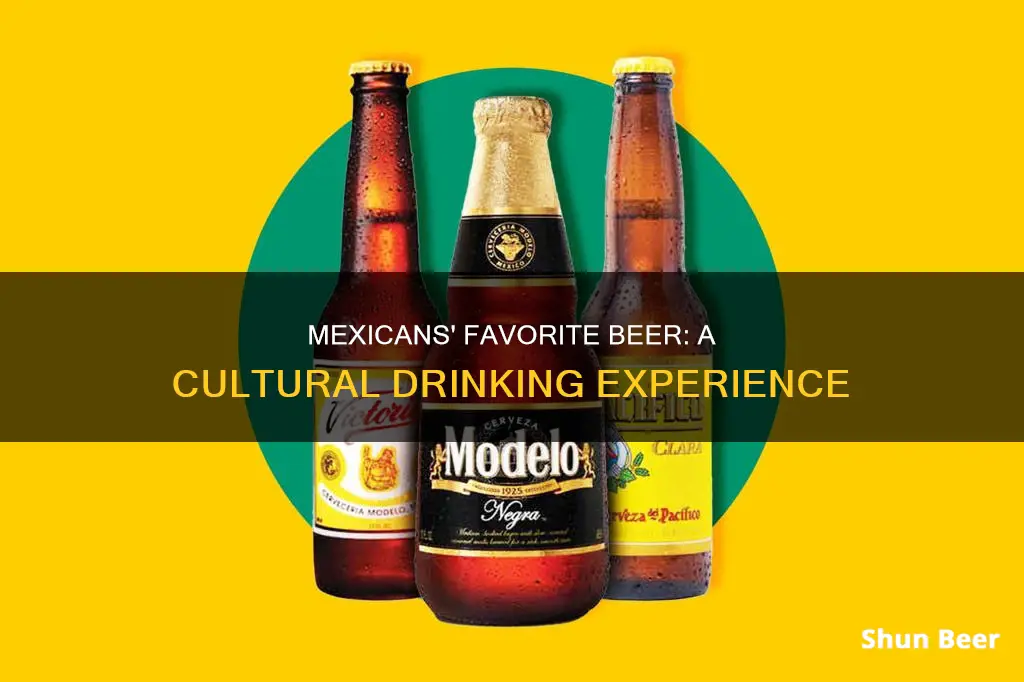
Mexico has a long history of beer brewing, dating back to the Spanish conquest of the Aztec Empire in the 16th century. While Mesoamerican cultures had their own fermented alcoholic beverages, the Spanish introduced European-style beer brewed with barley. Today, Mexico is one of the world's top beer-producing countries, with a diverse range of beers that are popular both domestically and internationally.
The Mexican beer market is dominated by two major corporations: Grupo Modelo and Cervecería Cuauhtémoc Moctezuma (formerly known as FEMSA Cerveza). Together, they control over 90% of the market and produce well-known brands such as Corona, Modelo, and Sol. These beers are characterised by their light, crisp flavour and are often enjoyed with a slice of lime, particularly on a warm, sunny day.
While the big two breweries dominate the market, there is also a growing craft beer scene in Mexico, with microbreweries popping up across the country and offering a diverse range of beers, from ales to stouts and IPAs.
| Characteristics | Values |
|---|---|
| Country of Origin | Mexico |
| Main Producers | Grupo Modelo, Cervecería Cuauhtémoc-Moctezuma |
| Beer Styles | Lager, Pilsner, Vienna-style light and dark beers, Munich dark beers, Ales |
| Popular Brands | Corona, Modelo, Sol, Tecate, Dos Equis, Carta Blanca, Superior, Indio, Bohemia, Pacífico, Estrella, León, Montejo, Victoria, Noche Buena, Negra Modelo, Barrilito, Michelada |
| Availability | Sold in Mexico and exported to various countries, including the US, UK, Europe, Asia, Australia, and Latin America |
| Serving Suggestions | Served cold, often with lime juice, or in a cocktail like Michelada |
What You'll Learn

Beer in Mexico: History and Origins
Even before the Spanish conquest of the Aztec Empire in the 16th century, fermented alcoholic beverages were consumed in Mexico. The best-known of these is pulque, which is made from the fermented sap of the maguey or agave plant. Another ancient beverage, called tesgüino or izquiate, is made from fermented corn and creates a light, amber-coloured liquid.
The first European-style beers brewed with barley were introduced by the Spaniards soon after Hernán Cortés' arrival. However, production was limited due to a lack of materials and heavy restrictions and taxes imposed by Spanish authorities. The first official concession to brew European-style beer was granted to Alfonso de Herrero in 1543 or 1544, though the exact location of his brewery is unknown. Despite the challenges, beer caught on with colonial authorities, and by the years leading up to independence, consumption was becoming established in Mexico.
After the Mexican War of Independence, these restrictions were lifted, and the industry was allowed to develop. An influx of German and Austrian immigrants during the Second Mexican Empire of Maximilian I of Mexico in the 19th century further contributed knowledge and expertise, leading to the opening of many breweries across the country. By 1918, there were 36 brewing companies, and beer had become big business. Prohibition in the United States during the 1920s also helped the Mexican beer industry, with Americans crossing the border to drink.
However, competition and consolidation led to the dominance of two major producers: Cervecería Modelo (or Grupo Modelo) and Cervecería Cuauhtémoc-Moctezuma owned by FEMSA. Today, these two conglomerates control over 90% of the Mexican beer market and have well-known brands such as Corona, Modelo, Pacifico, Sol, Dos Equis, and Tecate.
While most Mexican beers are lagers, pilsners, or Vienna-style light and dark beers, there is a growing trend of microbreweries and craft beers across the country, offering consumers more variety and choices.
Beer and Paracetamol: Safe Mix or Health Risk?
You may want to see also

Popular Domestic Mexican Beer Brands
Mexico has a long history of brewing beer, dating back to the Spanish conquest of the Aztec Empire in the 16th century. While fermented alcoholic beverages made from corn and the agave plant were consumed by Mesoamerican cultures before this time, the Spanish introduced the brewing of barley-based beers. Today, Mexico is one of the world's top beer-producing countries, with a diverse range of beers available. The country's beer market is dominated by two major conglomerates, Grupo Modelo and Cervecería Cuauhtémoc Moctezuma (formerly known as FEMSA Cerveza), which together supply over 90% of all beer in Mexico. Here is an overview of some of the popular domestic Mexican beer brands:
Corona
Corona, produced by Grupo Modelo, is one of the most well-known and widely consumed Mexican beers, both domestically and internationally. It is a light lager pilsner with a mild flavour and low bitterness. Corona is often served with a slice of lime and is particularly popular during the summertime. It is available in various bottle sizes, including the 250-ml Coronita and the 940-ml Corona Familiar.
Modelo
Modelo is another popular brand from Grupo Modelo. Modelo Especial, the company's second-most popular beer, is a pilsner-style beer available in bottles and cans. It has a slightly richer and fuller taste than Corona. Other variations include Modelo Light, a low-calorie version, and Negra Modelo, a dark beer also known as "the cream of the beers."
Tecate
Tecate is a medium lager with a sharp, strong taste. It was originally brewed in the town of Tecate, Baja California, and was the first beer to be canned for retail sales in Mexico. Tecate Light, introduced in 1992, was the country's first low-calorie beer. The brand is well recognised in Mexico due to its sponsorship of sporting events.
Sol
Sol is a light and tasty lager, originally produced for the working classes. It was relaunched in 1993 and has since gained popularity among young people. Sol is known for its sexy advertising and comes in several varieties, including Sol 2, Sol Cero (non-alcoholic), and Sol Limon y Sal, which is pre-mixed with lime and salt.
Dos Equis
Dos Equis, produced by Cervecería Cuauhtémoc Moctezuma, has two main varieties: Ambar (or Amber) and the clear lager version derived from it. The Ambar version is a Vienna-style dark beer that was first brewed in 1897. It was the company's best-selling brand in the 1940s and 1950s and remains a popular choice in Mexico and the United States.
Bohemia
Bohemia, also from Cervecería Cuauhtémoc Moctezuma, is known for its significant hops flavour and dense texture despite its clarity. It is considered one of the finest beers in the world and has won international recognition. Bohemia comes in several varieties, including Bohemia Obscura, a dark version, and Bohemia Weizen, the first wheat-based beer produced by a major brewery in Mexico.
Noche Buena
Noche Buena is a seasonal beer, typically available only between October and December. It is a strong-flavoured, dark copper-coloured bock-style beer with an alcohol content of 5.3%. Many people anticipate its annual release and enjoy it during the festive season.
Indio
Indio is a smooth, dark beer produced by Cervecería Cuauhtémoc Moctezuma. It was originally named Cuauhtémoc after the Aztec Emperor, but consumers began referring to it as "Indian" due to the image on the label. Indio is widely available and is known for its distinctive packaging and marketing.
Victoria
Victoria is a Pilsner-Vienna type beer that has been in production since 1865. It has a unique amber colour and a blend of light and dark beer flavours. It is a popular choice for those who want to enjoy a couple of beers while maintaining a clear head, as it has a lower alcohol content than some other beers.
Pacífico
Pacífico is a light and refreshing pilsner-type beer originally brewed in Mazatlán. It is Grupo Modelo's leading brand in the north-eastern region of Mexico and has been exported to the United States since 1985. A light version of Pacífico was introduced in 2008.
Carta Blanca
Carta Blanca is a pilsner-style beer and the oldest brand produced by Cervecería Cuauhtémoc Moctezuma. It was first marketed in 1890 and has won several awards for its taste and quality. Carta Blanca is known for balancing its grain and hops elements, making it a good pairing with spicy foods.
These are just a few of the many popular domestic Mexican beer brands. Mexico's beer culture is vibrant and diverse, offering a wide range of choices for beer enthusiasts to explore and enjoy.
WWII Beer: What Soldiers Drank During Wartime
You may want to see also

Microbreweries in Mexico
Mexico is one of the world's top beer-producing countries, with a large range of beers brewed domestically. However, small, independent microbreweries are not very common in Mexico and are far less prevalent than in places like the US and Europe. Nevertheless, there are some microbreweries operating in the country, including:
- Cerveceria San Angel in Mexico City
- Cerveceria Santa Fe Beer Factory in Mexico City
- Pepe and Joe's in Mazatlan
- Beer Lounge in Guadalajara
- Cerveceria Reforma in Mexico City
- Cerveceria Minerva in Zapopan
- Baja Brewing Company in San Jose del Cabo
- Cerveceria Insurgente in Tijuana
- Cerveceria de Colima
- Cerveceria Urbana in Mexicali
- Cerveceria Rrëy in Monterrey
- Cerveza Cosaco in Mexico City
- Escollo in Mexico City
- Taller de Cerveza la Graciela in Mexico City
- Cru Cru in Mexico City
- HOP: The Beer Experience in Mexico City
- Principia Tasting Room in Mexico City
These microbreweries tend to produce ales instead of the lagers and pilsners preferred by the two largest breweries in Mexico, which together supply over 90% of all beer in the country.
Recovering Alcoholics and Ginger Beer: Is It Safe?
You may want to see also

Beer Drinking Customs
Beer is a major part of Mexican culture, with over 63% of the population consuming one brand or another. Beer is also a significant export, with the country being the largest exporter in the world in 2022.
History
The history of beer in Mexico dates back to the Spanish conquest of the Aztec Empire in the 16th century. While fermented alcoholic beverages, including corn beer, were known before this, the Europeans introduced barley-based beers. Production was initially limited due to a lack of materials and heavy restrictions and taxes imposed by Spanish authorities. However, after the Mexican War of Independence, these restrictions were lifted, and the industry flourished.
The arrival of German immigrants in the 19th century further influenced the development of breweries in Mexico. By 1918, there were 36 brewing companies, but over time, the industry consolidated, and today, only two corporations, Grupo Modelo and Cervecería Cuauhtémoc Moctezuma, control 90% of the market.
Beer Culture
Mexican beer is typically lager-like, light-bodied, and meant to be consumed cold. It is commonly served with lime juice, and adding salt to the rim of the glass is also popular. Beer cocktails, such as the "michelada," are also common. A michelada typically consists of light beer, lime juice, salt, and sometimes chili powder, Worcestershire sauce, soy sauce, or tomato juice.
Commercial Beers
Mexico's beer market is dominated by two powerful companies, Cuauhtémoc-Moctezuma Brewery and Grupo Modelo, owned by Heineken and InBev, respectively. Some of the most popular commercial beers include:
- Corona: One of the top-selling beers worldwide, known for its light and mild flavor.
- Victoria: Known as the "wife of beers," it is a popular choice for those wanting a flavorful yet light beer.
- Indio: Often the cheapest option, with improved flavor over the years due to better ingredients.
- Sol: One of the oldest Mexican beer brands, known for its simple and inoffensive taste.
- Pacífico: A slightly more bitter and hefty option, especially popular in the western half of the country.
- Dos Equis: A reliable favorite, widely available, with the Ambar version being a dark Vienna-style lager.
- Bohemia: A more expensive, fancy option, known for its German-influenced bock-style beer with a sweetish, smoky flavor.
- Tecate: A beer chosen when other options are exhausted, with variations like Tecate Light and Tecate Titanium.
- Modelo: Marketed as a premium beer, it has a slightly heavier finish than Corona.
Craft Beers
While craft beers were once hard to find outside of Mexico City and Guadalajara, the laws have since been relaxed, and there is now a growing craft beer scene. These beers tend to be more expensive, but the quality is surprisingly good, with options like pale ales, stouts, wheat beers, and more.
Pregnant and Craving Root Beer? Is It Safe to Drink?
You may want to see also

Beer Tours in Mexico
Mexico has a rich history of brewing beer, dating back to the Spanish conquest of the Aztec Empire in the 16th century. While fermented alcoholic drinks, such as pulque, were consumed by Mesoamerican cultures before this time, the Spanish introduced barley-based beers. Today, Mexico is one of the world's top beer-producing countries, with two corporations, Grupo Modelo and Cerveceria Cuauhtémoc-Moctezuma, controlling over 90% of the market.
Day 1: Mexico City
Start your tour in Mexico City, where you can visit some of the country's oldest breweries. First, stop by the Cerveceria Modelo, founded in 1925, and try their famous Corona Extra, a light lager pilsner and the top-selling Mexican beer abroad. Next, head to Cerveceria Cuauhtémoc-Moctezuma's brewery to taste their principal beers, such as Sol, Tecate, and Dos Equis.
Day 2: Guadalajara
On day two, travel to Guadalajara, where you can visit the Cerveceria Estrella, which was bought by Grupo Modelo in 1954. Here, you can sample the Estrella beer, a regional brew mostly sold in Jalisco state and western Mexico.
Day 3: Monterrey
For the third day, venture to Monterrey, home to the Cerveceria Cuauhtémoc, one of the oldest and largest breweries in Mexico. Try their Carta Blanca, a pilsner-style beer that was first introduced in 1890.
Day 4: Mazatlán and Mérida
On your fourth day, head to the coastal city of Mazatlán to sample Pacífico, a pilsner-style beer named after the Pacific Ocean. This beer is Grupo Modelo's best-selling brand in northwest Mexico. Then, make your way to Mérida, where you can visit the Cerveceria Yucateca, acquired by Grupo Modelo in 1979. Here, you can taste the León and Montejo beers, the former being a Munich-style dark beer and the latter a light-tasting pilsner.
Day 5: Microbreweries
Spend your final day exploring some of Mexico's microbreweries, which are becoming increasingly popular. Visit places like Pepe's y Joe's in Mazatlán, Cerveceria San Angel and Cerveceria Santa Fe Beer Factory in Mexico City, and Beer Lounge in Guadalajara. These microbreweries often produce ales and offer a unique drinking experience compared to the larger breweries.
Throughout your trip, be sure to enjoy your beers with a slice of lime, the traditional Mexican way, and try a michelada, a beer cocktail made with lime juice, salt, and sometimes chili powder, Worcestershire sauce, or soy sauce.
Did Cheers' Norm Drink Real Beer?
You may want to see also
Frequently asked questions
The two main Mexican beer corporations, Grupo Modelo and Cervecería Cuauhtémoc Moctezuma, control over 90% of the Mexican beer market. Grupo Modelo's most popular beers include Corona, Modelo, Negra Modelo, Pacifico, Montejo, Leon, and Barrilito. Cervecería Cuauhtémoc Moctezuma's popular beers include Tecate, Sol, Dos Equis, Bohemia, Superior, Indio, and Carta Blanca.
The history of beer in Mexico dates back to the Spanish conquest of the Aztec Empire in the 16th century. While fermented alcoholic beverages, such as pulque, were consumed in Mexico prior to this, the Spanish introduced barley-based beers. The first official European-style brewery was opened in the 1540s by Alfonso de Herrero, one of Hernán Cortés's soldiers.
The majority of beers in Mexico are lagers, pilsners, Vienna-style light and dark beers, Munich dark beers, and ales produced by local microbreweries.
Mexicans typically drink their beer with lime and salt, and sometimes chili powder, Worcestershire sauce, soy sauce, or tomato juice. This drink is called a michelada.







